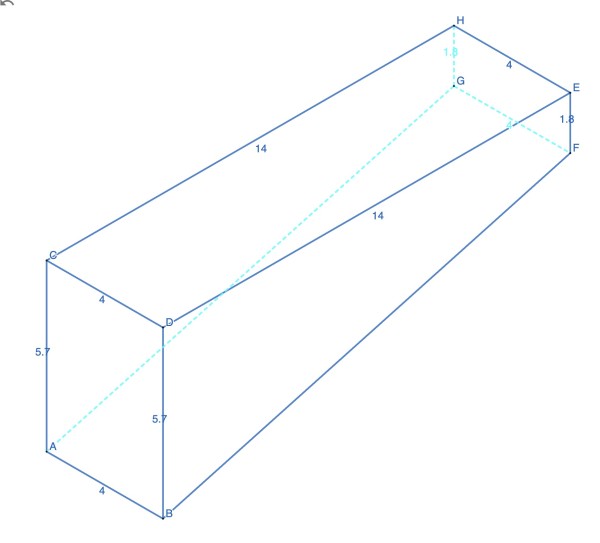No actual question has been posed, so let's assume that volumes are involved. If we ignore the steps for the moment, we have a swimming pool with a trapezoidal cross-section assuming that the base of the swimming pool is a straight slope from the shallow to the deep end. The area of the cross-section is given by the formula ½(a+b)c where a and b are the depths of the shallow and deep ends and c is the length of the pool. So this area=½(1.8+5.7)(14) m2=52.5m2. The volume v1 is found by multiplying by the width of the pool: 4×52.5=210m3, which is a capacity of 210000L in the absence of any structures within the pool.
Now we come to the steps, assumed to be in the water. If we also assume that the steps are effectively formed from 6 blocks, each block being a single step with volume=0.75×0.28×0.3=0.063m3. In this construction, the highest step (that is, the step aligned with the top of the pool) can be considered to be 3 blocks stacked on top of one another, the next step 2 such blocks, and the bottom step just 1 block, making 6 altogether. So the total volume of the steps v2=6×0.063=0.378m3. The capacity of the pool if completely filled is v1-v2=209.622m3.
1m3=1000L, so 209.622m3=209622L (L=litres).
So the capacity of the pool is about 209622L, starting with the premise that 1cc=1 cubic centimetre (cm)≡1 millilitre=1mL=10-3L. 1cm=10-2m, so 1cc=10-6m3, making 1m3=106cc≡103L. However if the three steps are supported all the way down to the sloping base of the pool by standing on a large block at the shallow end, then they will take up more additional volume (a little more than 9 extra 0.063m3 blocks because of the trapezoidal cross-section of the steps). The longer side (depth) of this trapezoid is found by using similar triangles (proportions of the sides). The shorter side will be 0.9m deep (half of the depth at the shallow end) and the longer side we'll call 0.9+x, so x/0.84=(5.7-1.8)/14, making x=0.234m, where 0.84m is the width of three steps (3×0.28). This makes the longer side 0.9+0.234=1.134m. Of course, I’m just speculating on what the question might be, but you have sufficient information to carry out any other calculations based on the given dimensions.
Below is an isometric representation of the pool without the steps showing the given dimensions. Rectangle HEFG is the shallow end and ABDC the deep end. The trapezoidal cross-section (DEFB and CHGA) is clearly seen. The visible edges are shown in solid blue while the hidden edges are in pale blue.
